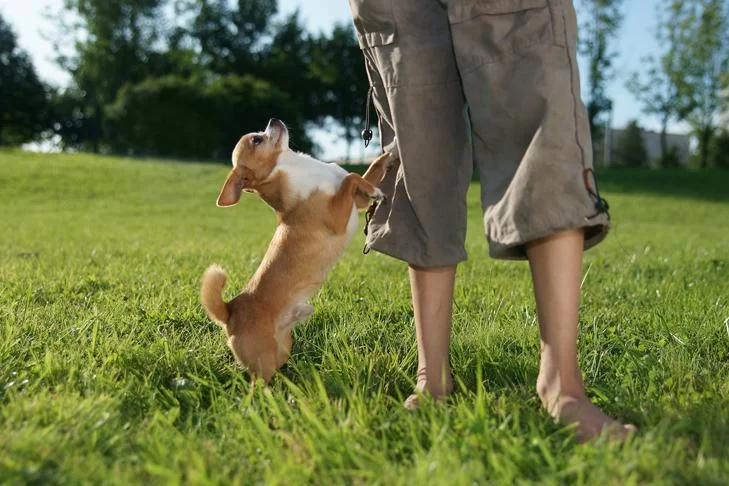- Understanding Dog Jumping Behavior
- Why Do Dogs Jump on Furniture?
- Training Techniques to Stop Jumping on Furniture
- Real-Life Example: Successfully Stopping a Dog from Jumping
- Additional Tips for Maintaining Good Behavior
- How Hidden Brook Veterinary Can Assist
Understanding Dog Jumping Behavior
Dogs are often playful, energetic, and eager to be close to their humans. While this behavior is generally affectionate, it can become problematic when dogs jump on the furniture, causing discomfort or damage to household items. Understanding why dogs engage in this behavior is crucial to addressing it effectively.
Jumping on furniture is a natural expression of excitement or the desire to be close to their owners. However, without proper guidance, this behavior can quickly become ingrained, and it may escalate into an issue that disrupts your home life. The key to managing this behavior lies in consistency and clear boundaries for your dog.
Why Do Dogs Jump on Furniture?
There are several reasons why dogs jump on furniture. One of the primary reasons is to seek attention or to be closer to their owners. Dogs, especially puppies or those with high energy, often associate furniture with comfort and security. If they receive attention when they jump up, they learn that jumping results in positive reinforcement.
Additionally, some dogs jump on furniture out of curiosity or the desire to explore. Dogs are naturally inquisitive, and your couch or bed may seem like an exciting new territory to investigate. Without the proper training, they may jump on and off furniture as a form of entertainment or to access a new view of their surroundings.

1946 S Christopher Columbus Blvd, Philadelphia, PA 19148, USA
See DetailsTraining Techniques to Stop Jumping on Furniture
The key to stopping your dog from jumping on the furniture is teaching them clear boundaries and rewarding good behavior. Here are some training techniques that can help:
- Teach a "No Jump" Command: Consistently use a verbal cue, such as "no jump," whenever your dog attempts to jump on furniture. It's important to use this command consistently and immediately after the unwanted behavior to reinforce the connection between the action and the correction.
- Provide an Alternative: Instead of punishing your dog, redirect their attention by offering a designated spot, such as a dog bed, where they are allowed to relax. Reward them when they go to their designated space, reinforcing the idea that they can be calm and comfortable in a place they are allowed.
- Consistency is Key: Consistency is vital for training success. Every time your dog attempts to jump on the furniture, use the "no jump" command and gently guide them away. Over time, your dog will learn that jumping on the furniture is not acceptable, and the behavior will decrease.
- Reward Calm Behavior: Positive reinforcement works wonders. When your dog chooses not to jump on the furniture or sits calmly on their designated spot, reward them with treats or affection. This reinforces the behavior you want to encourage.
Real-Life Example: Successfully Stopping a Dog from Jumping
Take the example of Daisy, a golden retriever who loved to jump on the couch whenever her owner, Claire, sat down. Daisy was well-meaning, but her constant jumping made it difficult for Claire to enjoy her space. Claire started using the "no jump" command every time Daisy tried to leap onto the furniture. She also created a cozy dog bed next to the couch, where Daisy was encouraged to relax.
After a few weeks of consistent training, Daisy began to associate the dog bed with relaxation and calm behavior. She would only jump on the furniture when Claire invited her up, reinforcing the idea that she had a place where she was allowed to rest. Claire’s bond with Daisy strengthened as they enjoyed peaceful moments together without the constant jumping interruptions.
Additional Tips for Maintaining Good Behavior
Beyond training, there are a few additional tips that can help maintain good behavior when it comes to your dog and furniture:
- Set Boundaries from the Start: If you don’t want your dog on the furniture, it’s important to establish boundaries early on. This will prevent confusion later and ensure that your dog understands where they are allowed to go.
- Exercise and Mental Stimulation: Dogs are less likely to engage in undesirable behaviors like jumping if they are mentally and physically stimulated. Regular exercise and playtime can help burn off excess energy, making your dog more likely to relax when indoors.
- Use Furniture Covers: If your dog is particularly persistent, consider using furniture covers to protect your sofas or beds. This can help prevent damage while you work on training your dog.
How Hidden Brook Veterinary Can Assist
If you're struggling with your dog's behavior and need professional guidance, Hidden Brook Veterinary is here to help. Our team of experts can provide advice on behavior modification, recommend training resources, and offer products that can assist in managing your dog's actions, such as calming aids or furniture-friendly dog beds. We understand how important it is to create a peaceful home environment for both you and your pet, and we’re committed to helping you achieve that.
Contact us today for personalized advice or to learn more about our services and products that can assist in your dog’s training journey.











